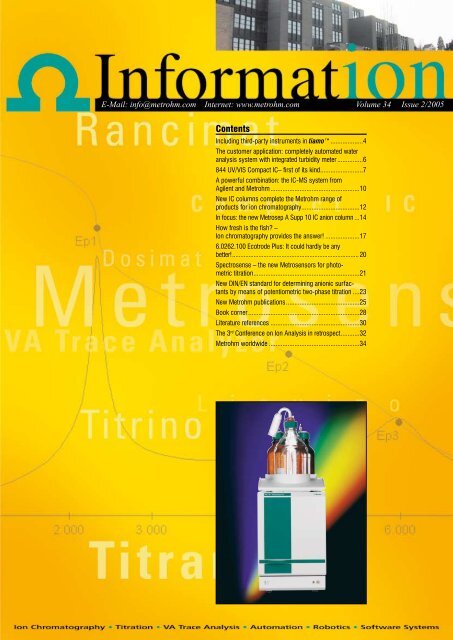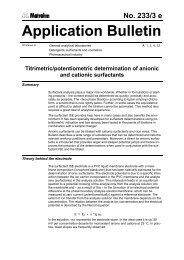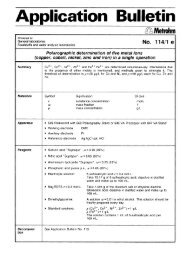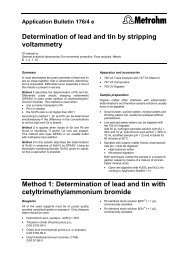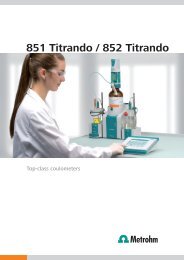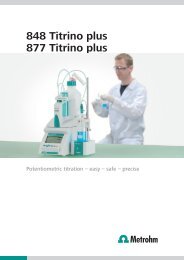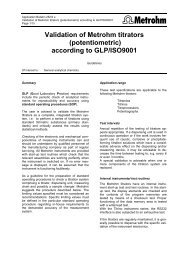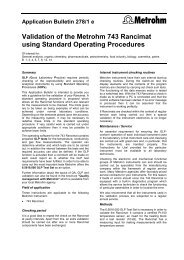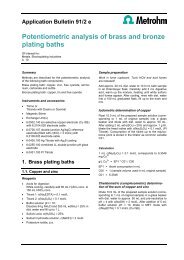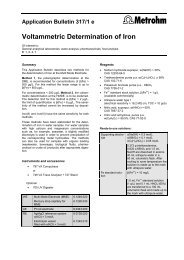Download (PDF) - Metrohm
Download (PDF) - Metrohm
Download (PDF) - Metrohm
You also want an ePaper? Increase the reach of your titles
YUMPU automatically turns print PDFs into web optimized ePapers that Google loves.
E-Mail: info@metrohm.com Internet: www.metrohm.com Volume 34 Issue 2/2005ContentsIncluding third-party instruments in tiamo...................4The customer application: completely automated wateranalysis system with integrated turbidity meter................6844 UV/VIS Compact IC– first of its kind.........................7A powerful combination: the IC-MS system fromAgilent and <strong>Metrohm</strong>.....................................................10New IC columns complete the <strong>Metrohm</strong> range ofproducts for ion chromatography..................................12In focus: the new Metrosep A Supp 10 IC anion column....14How fresh is the fish? –Ion chromatography provides the answer!.....................176.0262.100 Ecotrode Plus: It could hardly be anybetter!............................................................................. 20Spectrosense – the new Metrosensors for photometrictitration..............................................................21New DIN/EN standard for determining anionic surfactantsby means of potentiometric two-phase titration.....23New <strong>Metrohm</strong> publications...........................................25Book corner..................................................................28Literature references.....................................................30The 3 rd Conference on Ion Analysis in retrospect...........32<strong>Metrohm</strong> worldwide......................................................34
Editorial<strong>Metrohm</strong> Ltd.CH-9101 HerisauSwitzerlandPhone +41 71 353 85 85Fax +41 71 353 89 01E-Mail info@metrohm.comInternet www.metrohm.comDear Customers,<strong>Metrohm</strong> Information provides me with an excellent opportunity of introducing myselfto you. Perhaps you are already aware that there has been a managementchange in the <strong>Metrohm</strong> Group. Since 1 January 2005 I have been responsible forthe management of our headquarters in Herisau. During 2006 Mr. Déteindre will introduceme to the international issues of the company in detail, so that from 1 January2007 I will take over the group management. It is intended that Mr. Déteindrewill take over a new function in the <strong>Metrohm</strong> Group. As you can see, at <strong>Metrohm</strong>it is not just instrument development that is subject to long-term and very carefulplanning, but also management duties and the personnel changes that this involves.We are convinced that such a procedure is in the best interests of our customersas well as our employees and all the other stakeholders. One of the central aimsof this transition consists in safeguarding the <strong>Metrohm</strong> philosophy or, to expressit differently, the corporate culture that has certainly been a decisive factor in oursuccess during the past 62 years. Far too many times a management change isunfortunately synonymous with a change in strategy. Let me say right away thatsuch a change is not under discussion at <strong>Metrohm</strong>. Of course, this does not meanthat everything will remain exactly the same as it is. Nothing is as certain as constantchange. In future your partner <strong>Metrohm</strong> will continue to do everything it canto realize your wishes and ideas. One of my major interests is not only maintainingcustomer satisfaction, but increasing it wherever possible. I would like to askfor your active cooperation in this matter. Help us to develop the optimal analyticalinstruments for you. We want to provide you with tools that enable you to gain anadvantage over your competitors, so that you in turn will also be successful. As aformer supplier to the pharmaceutical industry I am used to satisfying the highestdemands. With our experienced development team, efficiently manufactured Swissquality products, lean organizational structures and a worldwide well-trained andcustomer-oriented team providing advice and service, we are pleased to accept anychallenge. Not only the conviction that customer relations are also a major concernfor top management, but also the fact that I like to be in direct contact with our customersshould provide a good basis for a mutually successful future.Finally I would like to thank you for your previous good cooperation with <strong>Metrohm</strong>. Ilook forward to a trusting and professional business relationship in the future.Best regards,Imprint<strong>Metrohm</strong> Information is a customermagazine from <strong>Metrohm</strong> Ltd. and ispublished three times a year in Englishand German.Please contact us if you wish to receiveyour own copy regularly.Dr. Christoph FässlerCOO <strong>Metrohm</strong> HeadquartersPublished by: <strong>Metrohm</strong> Ltd.,CH-9101 Herisau,SwitzerlandEditor: Claudia Denglercd@metrohm.comPrinted by: <strong>Metrohm</strong> Ltd.Internet: www.metrohm.infoISSN 1424-0904 <strong>Metrohm</strong> Information Issue 2/2005
EditorialBrief portrait of Dr. Christoph Fässler1952 born in Switzerland, married for 25 years. 2 daughters (18 and 20 yearsold).1980 obtained doctorate as chemical engineer from ETH (Swiss Federal Institute ofTechnology) in Zurich.1980–1986 active in the USA, Egypt, Brazil and Mexico in the quality, productionand management sectors for Messrs. Holcim (formerly Holderbank).1986–1998 CEO of Messrs. forma vitrum ag, a Swiss company active worldwide,producing primary packaging material for the pharmaceutical industry.1998–2001 Sectional Manager Pharmaceutical Packaging (11 production companiesworldwide) for the German Schott Group.2001–2004 Divisional Manager Pharmaceutical Systems (21 production companiesworldwide) for the German Schott Group.Since 1994 member of the Supervisory Board of <strong>Metrohm</strong> Ltd.Knowledge of theworld is onlyto be acquired inthe world,and not in a closet.Lord Chesterfield<strong>Metrohm</strong> Information Issue 2/2005 3
Third-party instruments in tiamoIncluding third-party instruments in tiamotiamo – titration and more. The name says it all. tiamo controls not only individualtitrators and takes care of the data management. No, complete automated titrationsystems can also be controlled by tiamo. This leaves nothing to be wished for. Oris there something?Measurement of density, turbidity and refractive indexAutomated titration systems determine parameters such as alkalinity, total acidity,chloride content and pH value. However, in daily laboratory work additional sampleparameters such as density, turbidity or refractive index are often required. Suchmeasurements are usually carried out manually, using third-party instruments, andthe results obtained are stored in a separate database.Would it not be much more practical to determine these additional parameters in thesame automated titration system and manage all the analytical results in a commondatabase? In such cases tiamo provides an elegant solution!The DMA 4500 Density Meter from Anton Paar – justone example of a third-party instrument that has alreadybeen successfully included in tiamo.Serial communicationThe innovative tiamo software allows bidirectional communication with instrumentsthat are not included as standard.The new instrument is simply connected to the PC via the serial RS 232 interface.The tiamo method sequence now allows commands to be transmitted to the instrumentas well as data to be received from it: This means that the third-party instrumenthas become an integral part of the <strong>Metrohm</strong> titration system! The samples areprepared and then transferred to the third-party instrument using a pump or a dosingsystem. tiamo now starts the measurement. If special parameters are requiredfor this then tiamo can first transmit them to the third-party instrument. When themeasurement has been successfully concluded, tiamo calls up the measuring data <strong>Metrohm</strong> Information Issue 2/2005
Third-party instruments in tiamofrom the instrument. These results are then further processed or stored directly inthe tiamo database.tiamo saves time and moneyThanks to the integration of third-party instruments into an automated <strong>Metrohm</strong>titration system, it is not only possible to determine additional analytical parameters,but you can also do without a separate sample changer and a separatecontrol and database software. The operation of the integrated third-party instrumentstakes place via a simple and intuitive software interface, which both reducesfamiliarization time and increases operational reliability.The following third-party instruments have already been successfully included intiamo; in view of the great demand this list will be continually extended:• Density meter from Anton Paar• Turbidity meter from Hach Company (see the customer application described inthe following article)• Refractometer from Reichert• Polytron homogenizer from Kinematica• Thermostattable water bathtiamo – titration and more. Analytical solutions from a single supplier. Automationcompetence with a worldwide reputation.Please find additional information on our innovative tiamo control and databasesoftware underwww.titration-and-more.comFaced with the choicebetween changing one’smind and proving thatthere is no need to do so,almost everyone getsbusy on the proof .John Kenneth Galbraith<strong>Metrohm</strong> Information Issue 2/2005 5
844 UV/VIS Compact IC844 UV/VIS Compact IC – first of its kindWith the 844 UV/VIS Compact IC, <strong>Metrohm</strong> presents the first compact ion chromatographwith UV/VIS detection worldwide. This instrument impresses with thefollowing features:• Favorable purchase price and low operating costs• Easy and powerful system control with IC Net or IC Cap software• Small footprint means very small space requirements• High precision• Low detection limits• PEEK flow path – fully solvent-compatible• High-quality system and components made in SwitzerlandExtremely compact design combined with leading technologyand very easy operation: the new 844 UV/VISCompact IC.Leading technology• Diode-array detector (DAD)• Three wavelengths plus freely selectable reference wavelength• Peak-ratio channel• Variable bandwidths for detection wavelength (peak bunching)• Scan mode for spectra recording and simple system optimization• Combined UV and VIS lamp system• No lamp change• Integral post-column reactor (PCR)• Column heating for two separation columnsInstrumentThe 844 UV/VIS Compact separates and determines substances that absorb in theultraviolet or visible part of the spectrum. The introduction of this system opens awide range of applications that are not directly accessible to ion chromatographywith conductivity detection.Some important application fields are:• Detection of heavy metals• Wastewater containing chromium in leather production• Corrosion checks in power plants• Determination of bromate in drinking water• Determination of sulfur compounds in wastewater• Measurement of nitrite and nitrate in seawater<strong>Metrohm</strong> Information Issue 2/2005 7
844 UV/VIS Compact ICIn the 844 UV/VIS Compact IC, all system components are integrated into its compactprotective housing: injector, high-pressure pump, column heating, post-columnreactor, reagent pump and the newly developed diode-array UV/VIS detector.The complete system can be controlled by PC via the robust IC Net software, allowingfor easy and logical operation. With the addition of IC Cap software, operationis simplified even further through system control via a single mouse-click. Optimaldata acquisition allows data evaluation even while the chromatogram is being recorded.The large range of Metrosep separation columns guarantees high returnsof analytical success by teaming up the corresponding column to even the mostdifficult of applications.The housing of the 844 UV/VIS Compact IC contains everything youneed for ion chromatography with photometric detection.Multiple applicationsIn combination with the different Metrosep separation columns, the 844 UV/VISCompact IC opens up a wide range of applications. Below you will find a few examplesfrom our extensive application library.Determination of bromate in drinking water from Herisauusing post-column derivatization and UV/VIS detection(post-column reaction with KI + ammonium molybdate;wavelength 352 nm).Separation column: Bromate column (6.1005.110)Eluent: 100 mmol/L H 2SO 4Flow rate:1.0 mL/minInjection volume: 1000 µLResult:0.13 µg/L bromate <strong>Metrohm</strong> Information Issue 2/2005
844 UV/VIS Compact ICDetermination of sulfide, sulfite and thiosulfate in a standardsolution (concentration 1.0 mg/L each) using UV/VIS detection (wavelength 205 nm).Separation column: Metrosep A Supp 5 – 100(6.1006.510)Eluent: 4.0 mmol/L Na 2CO 3Flow rate:0.7 mL/minInjection volume: 1000 µLDetermination of nitrite and nitrate in seawater (synthetic;concentration 0.1 mg/L each; dilution 1 : 10) usingUV/VIS detection (wavelength 215 nm).Separation column: Metrosep A Supp 5 – 250(6.1006.530)Eluent: 1.0 mmol/L NaHCO 3,3.2 mmol/L Na 2CO 3Flow rate:0.7 mL/minInjection volume: 10 µLPlease find additional information on the new 844 UV/VIS Compact IC and allother <strong>Metrohm</strong> products for ion chromatography on our Website underwww.metrohm.com/products/ic.htmlWhy not also take the opportunity and subscribe to the <strong>Metrohm</strong> IC Newsletterunderwww.ic-userclub.comOnce a month, this E-Mail newsletter informs about our IC instruments,columns and software, describes interesting applications and provides informationon events and literature concerned with ion chromatography. Inshort: You learn everything worth knowing from the world of IC – free ofcharge and up to date.Take advantage of this <strong>Metrohm</strong> service!<strong>Metrohm</strong> Information Issue 2/2005 9
IC-MS systemA powerful combination: the IC-MS system from Agilent and <strong>Metrohm</strong>Why IC-MS?The combination of the two techniques ion chromatography (IC) and mass spectrometry(MS) guarantees improved sensitivity and lower detection limits, as matrixinterference is reduced to the absolute minimum. Thanks to the highly selectivedetection by mass spectrometry, the obtained substance peaks can be identifiedunambiguously. The technique can also be used for the structural analysis of largermolecules. In addition, IC-MS is suitable for element speciation and offers the possibilityof differentiating between organic and inorganic compounds of one and thesame element. Tandem conductivity and mass spectrometric detection provideseven more comprehensive information on the samples to be analyzed.The combined IC-MS system consisting of a <strong>Metrohm</strong> MIC-2 Advanced IC System with 838 Advanced IC Sample Processor and an Agilent MSD SL mass spectrometer.First system component: <strong>Metrohm</strong> IC• Automated MIC-2 Advanced IC System• First-class modular ion chromatography system• Easy operation, easy maintenance• 100% solvent-compatible• Large range of separation columns for a wide variety of applications• Full control by Agilent ChemStation software10 <strong>Metrohm</strong> Information Issue 2/2005
IC-MS systemSecond system component: Agilent MS• 1100 Series MS detector• Single-stage quadrupole mass spectrometer with electrospray ionization (ESI)• Easy operation, easy maintenance• Very robust thanks to orthogonal arrangement of the ion source• Mass range m/z = 2...3000• Multi-signal acquisition in one run, for example SIM + , SIM – , Scan + , Scan –• Eluent flow rate up to 1 mL/min for columns with 2 to 4 mm inner diameterInteresting applicationsWith the IC-MS system from Agilent and <strong>Metrohm</strong> even complex separation problemscan be solved reliably, fully automatically and with excellent precision. Thespectrum of applications ranges from the determination of 0.1 ppb perchlorate inthe presence of a 10’000’000-fold excess of chloride, carbonate and sulfate to thedetection of aliphatic carboxylic acids in brine and to the determination of traceamounts of bromate in drinking water.Close-up of the mass spectrometer’s electrospray ionization(ESI) interface.Determination of 1 ppb perchlorate in the presence of1 g/L each of chloride, carbonate and sulfate (chromatogramsin SIM – mode).Separation column: Metrosep A Supp 5 – 100(6.1006.510)Eluent:Flow rate:30 mmol/L NaOH, 30% methanol0.8 mL/minDetermination of five aliphatic carboxylic acids in 100 g/LNaCl solution [chromatograms in SIM – mode at m/z =59 (1), 73 (2), 87 (3), 101 (4), 115 (5)].Separation column: Metrosep Organic Acids – 100(6.1005.210)Eluent:0.25 mmol/L oxalic acidFlow rate:0.4 mL/minPost-column reagent: 300 mmol/L NH 3(0.25 mL/min)Sample:100 g/L NaCl solution with 1 ppmacetate (1), propionate (2), butyrate(3); 1 ppb valerate (4), capronate(5)<strong>Metrohm</strong> Information Issue 2/2005 11
New separation columns for ICNew IC columns complete the <strong>Metrohm</strong> range of products for ionchromatography<strong>Metrohm</strong> has included various new IC separation columns in its product range. Inaddition to the favorably-priced Metrosep A Supp 10 (see report on page 14), wepresent three new columns for attractive special applications: Whether anions inbrine, the determination of pharmaceutical ingredients such as paracetamol andcaffeine or the isocratic separation of glycolate and acetate – <strong>Metrohm</strong> can now offersuitable columns for all these applications.Column specificationsColumn dimensions 250 mm x 4.0 mmSeparation material Polyvinyl alcoholwith quaternary ammoniumgroupsParticle size 5 µmpH range 3...12RecommendedprecolumnMetrosep RP Guard(6.1011.020)Metrosep A Supp 7 – 250 (6.1006.630)The Metrosep A Supp 7 has been specially developed for the simultaneous determinationof oxohalides, standard anions and dichloroacetic acid. However, thisimportant application is by far not the only field of use of this new high-performanceIC column. It is also ideally suitable for the isocratic separation of glycolateand acetate – this means that it is now possible to dispense with costly gradientsystems.The disinfection by-products (DBP) generated in water treatment plants are suspectedto be not only a general health hazard, but could even be carcinogenic.For this reason the oxohalides are the subject of many investigations and standardmethods (e.g. EPA 300.1 Part B, EPA 317.0). Most attention is being givento bromate, which is produced from bromide during the ozonization of drinkingwater.With the new Metrosep A Supp 7 IC column the oxohalides, standard anions anddichloroacetic acid can now be determined reliably and accurately down to the lowppb range. The polyvinyl alcohol separation material with a particle diameter of only5 µm guarantees extremely high plate numbers and thus high chromatographicefficiency. A temperature of 45 °C is required for the separation.A further interesting field of application for the Metrosep A Supp 7 is monitoring thecooling water in nuclear power plants. Too high ion concentrations accelerate thecorrosion of the piping systems and must therefore be avoided at all costs. Thismeans that an accurate monitoring system that functions 100% is absolutely essential.Apart from acetate, which is added to the cooling water as an additive, anyglycolate present as a contaminant also has to be determined.Glycolate and acetate are separated isocratically, that is without the use of agradient system that would otherwise be required for this application (see chromatogrambelow). Applying the preconcentration technique, it is possible to reliablydetermine concentrations as low as 100 ppt in the original solution.Determination of glycolate, acetate and formate besidesthe standard anions using the Metrosep A Supp 7 – 250IC column. As can be seen from the enlarged section ofthe chromatogram, glycolate and acetate are separatedat the baseline.Eluent: 3.5 mmol/L Na 2CO 3Flow rate: 0.8 mL/minSample: Standard containing 0.5 ppm fluoride,chloride, nitrite, bromide, nitrate, phosphate,sulfate; 5 ppm glycolate, acetate,formateTemperature: 45 °CDetection: Conductivity12 <strong>Metrohm</strong> Information Issue 2/2005
New separation columns for ICMetrosep A Supp 8 – 150 (6.1017.010)Determination of anions in brine samples? Previously this application could onlybe realized by carrying out complicated and time-consuming sample preparationsteps. With the new high-capacity Metrosep A Supp 8 «salt column» the ion chromatographicdetermination is now possible without any sample purification. Theanions are detected photometrically; our new 844 UV/VIS Compact IC is ideal forthis application.If eluents with high ion concentrations (10% NaCl solution) are used then samplesolutions containing up to 30% NaCl can be injected. In this way detection limits inthe low ppb range can be achieved.Column specificationsColumn dimensions 150 mm x 4.0 mmSeparation material Styrene/divinylbenzenecopolymer with quaternaryammoniumgroupsParticle size 5 µmpH range 0...14Recommendedprecolumn Metrosep A Supp 8Guard (6.1017.500)[Determination of nitrite, bromide and nitrate in brine usingthe Metrosep A Supp 8 – 150 separation column(with Metrosep A Supp 8 Guard precolumn).Eluent: 100 g/L NaClFlow rate: 1.0 mL/minTemperature: 22 °CDetection: UV at 215 nmResults: Nitrite 50 ppbBromide 1.4 ppmNitrate 120 ppbProntoSIL 120-5-C18 AQ (6.1008.100)In the field of determination of pharmaceutical ingredients, the 844 UV/VIS CompactIC opens up a multitude of new applications for ion chromatography. With theProntoSIL 120-5-C18 AQ a suitable IC separation column is now available for theseapplications.The separation and determination of broad-spectrum antibiotics (cefazolin, amoxicillin,ampicillin, etc.) or painkillers such as acetylsalicylic acid (aspirin) andparacetamol (known as acetaminophen in North America) can be carried out withthe 844 UV/VIS Compact IC and ProntoSIL 120-5-C18 AQ just as fast and reliablyas determining the caffeine content of cola drinks.Column specificationsColumn dimensions 150 mm x 4.0 mmSeparation material Silica gel C18Particle size 5 µmpH range 2...9RecommendedprecolumnProntoSIL 120-5-C18AQ Guard (6.1008.110)Determination of paracetamol, caffeine and 4-hydroxybenzoicacid at three different wavelengths using theProntoSIL 120-5-C18 AQ IC column.Eluent: 20 mmol/L H 2SO 4in acetonitrile/water(15:85 v/v)Flow rate: 1.0 mL/minSample: Standard containing 20 ppm paracetamol,caffeine, 4-hydroxybenzoic acidTemperature: 22 °CDetection: UV at 220 nm, 254 nm, 270 nm<strong>Metrohm</strong> Information Issue 2/2005 13
Metrosep A Supp 10In focus: the new Metrosep A Supp 10 IC anion columnWith the Metrosep A Supp 10, <strong>Metrohm</strong> presents a favorably-priced anion columnthat is not only suitable for the determination of the standard anions, but also forcomplex applications. The straightforward separation of sulfite and sulfate is just oneexample of the wide range of uses of this new IC column. An additional advantage ofthe Metrosep A Supp 10 is the position and small size of the system peak (carbonate),which appears clearly before the chloride peak and therefore does not interferewith the determination (see the following two chromatograms).The separation of sulfite and sulfate can be achieved evenwith the 50 mm version of the Metrosep A Supp 10.Separation column: Metrosep A Supp 10 – 50(6.1020.050)Eluent: 5.0 mmol/L Na 2CO 3,5.0 mmol/L NaHCO 3Flow rate:1.0 mL/minTemperature: 45 °CPosition of the system peak using a carbonate/hydrogencarbonate eluent.Separation column: Metrosep A Supp 10 – 100(6.1020.010)Eluent: 5.0 mmol/L Na 2CO 3,5.0 mmol/L NaHCO 3Flow rate:1.0 mL/minTemperature: 45 °CThe new Metrosep A Supp 10 is based on a high-capacity styrene/divinylbenzenecopolymer with a particle size of only 4.6 µm. <strong>Metrohm</strong> has developed and optimizedthis well-proven column design even further. The result is an extremely robustanion column with excellent separation performance and adjustable selectivity.In chromatographic work the selectivity of the column with respect to the substancesto be determined is of great importance, particularly when separating componentswith very similar properties. In contrast to HPLC, for example, in ion chroma-14 <strong>Metrohm</strong> Information Issue 2/2005
Metrosep A Supp 10tography the elution sequence is normally determined by the charge and radius ofthe ions. Only a few IC separation columns offer the possibility of altering the selectivitytowards individual ions by changing external parameters such as temperature,pH value of the eluent or the eluent composition in general.The new Metrosep anion column has this characteristic. Its separation propertiescan be altered by varying the above-mentioned parameters and thus be perfectlymatched to the particular application. The Metrosep A Supp 10 is extremely flexibleregarding alterations in selectivity. It is, for example, possible to shift the bromideand nitrate peaks widely within the chromatogram by just varying the column temperature.As shown in the following diagram, the retention times of these anionsbecome shorter as the temperature increases.Shifting of the bromide and nitrate peaks within the chromatogramby varying the column temperature.Separation column: Metrosep A Supp 10 – 100(6.1020.010)Eluent: 5.0 mmol/L Na 2CO 3,5.0 mmol/L NaHCO 3Flow rate:1.0 mL/minTemperature: 25...70 °CIf the standard eluent (5.0 mmol/L Na 2CO 3, 5.0 mmol/L NaHCO 3) is used then thephosphate peak appears unusually early in the chromatogram: Phosphate alreadyelutes between nitrite and bromide. However, by varying the eluent composition,the phosphate peak can also be shifted within the chromatogram, which allows anadaptation to the given separation problem.The tailing of bromide and nitrate caused by the column’s basic material is minimizedby increasing the temperature or by adding small amounts of perchlorate tothe eluent. <strong>Metrohm</strong> recommends either using the standard eluent and a columntemperature of 45 °C or, if no column oven is available, adding 5 µmol/L perchlorateto the eluent (see diagram below).Comparison of the standard chromatograms obtainedunder the recommended conditions.Separation column: Metrosep A Supp 10 – 100(6.1020.010)Eluent: (a) 5.0 mmol/L Na 2CO 3,5.0 mmol/L NaHCO 3(b) 5.0 mmol/L Na 2CO 3,5.0 mmol/L NaHCO 3,–5 µmol/L ClO 4Flow rate:1.0 mL/minSample:Standard containing 2 ppm chloride;5 ppm nitrite; 10 ppm phosphate,bromide, nitrate, sulfateTemperature: (a) 45 °C(b) 30 °C<strong>Metrohm</strong> Information Issue 2/2005 15
Metrosep A Supp 10As the examples show, the separation properties of the Metrosep A Supp 10 canbe varied within a wide range. This allows the new IC anion column to be adjustedto a vast number of applications, thus replacing some of the special columns thatwere previously required.Four different column lengths to choose fromThe new Metrosep anion column is available in four different lengths ranging from50 mm to 250 mm:• Metrosep A Supp 10 – 50 (6.1020.050):For simple separation problems and unproblematic sample matrices.• Metrosep A Supp 10 – 75 (6.1020.070):For rapid sample throughput and samples with a high ionic strength, for examplefor the analysis of cola drinks or air analysis.• Metrosep A Supp 10 – 100 (6.1020.010):Very good separation performance with moderate chromatographic run times;universally applicable anion separation column.• Metrosep A Supp 10 – 250 (6.1020.030):For samples with a high ionic strength, for complex separation tasks and foranalyses with very large differences in concentration between the individualcomponents.Column specificationsColumn dimensions 50 mm x 4.0 mm (6.1020.050)75 mm x 4.0 mm (6.1020.070)100 mm x 4.0 mm (6.1020.010)250 mm x 4.0 mm (6.1020.030)Separation materialParticle size 4.6 µmpH range 0...14Recommended precolumnStyrene/divinylbenzene copolymer with quaternaryammonium groupsMetrosep A Supp 10 Guard (6.1020.500) orMetrosep A Supp 10 S-Guard (6.1020.510)He will neverhave true friendswho is afraidof making enemies.William Hazlitt16 <strong>Metrohm</strong> Information Issue 2/2005
Biogenic amines in fishHow fresh is the fish? – Ion chromatography provides the answer!Fish and the products made from them are very nutritious foodstuffs. They providea lot of protein, fat, numerous vitamins (A, B and D vitamins), minerals (potassium,phosphorus, etc.) and trace elements (e.g. iodine and selenium in sea fish). Thefat content of the different types of fish varies greatly. In general, fish fats have ahigh proportion of unsaturated essential fatty acids, which, just like the fish’s highprotein content (approx. 20%), favors rapid decomposition. This is why maintainingthe freshness of the fish throughout the whole production chain: fishing grounds –processing – shop – customer presents a major challenge to the fishing industry.As spoiled fish no longer has any commercial use, reliable methods for checkingthe freshness are of immense importance for both producers and consumers.From an analyst’s point of view there are three groups of substances that are particularlyinteresting as «freshness indicators»:• Total content of volatile N-bases (total volatile nitrogenous bases – TVB-N)• Content of trimethylamine N-oxide (TMAO)• Content of biogenic amines (in fish primarily histamine, putrescine and cadaverine)Within the EU the maximum permitted TVB-N content in different sea fish is governedby the Council Directive 95/149/EC. TVB-N concentrations in the range5...100 mg/100 g sea fish can be determined. However, the titration method usedis time-consuming and determines only a sum parameter.Various components contribute to the «spoiling parameter» for fish. This is firstlythe microbiological degradation of TMAO (which serves to regulate the osmoticpressure in fish) to trimethylamine (TMA) and ammonia. Further substances, whichare also formed during the degradation of fish protein by microorganisms, are summarizedunder the collective term biogenic amines. These are histamine, putrescineand cadaverine. As histamine is one of the substances that trigger allergies, its exactdetermination is of great general interest.In order to be able to determine the «freshness indicators» in sea fish accurately,the Cantonal Laboratory in Schaffhausen, Switzerland (Ms. Oechslin, Ms. Steil) hasdeveloped a new ion chromatographic method. This procedure allows the simultaneousdetermination of dimethylamine (DMA), trimethylamine (TMA), trimethylamineN-oxide (TMAO), histamine, putrescine and cadaverine and can be used fornitrogen concentrations of 5 to 1500 mg/kg fish.Following this, Sigma-Aldrich Chemie GmbH (formerly Fluka) in Buchs, Switzerland,and <strong>Metrohm</strong> Ltd. in Herisau have cooperated to produce an analysis kit fortesting 10 sea fish samples (Fluka no. 53851). In addition to the necessary IC precolumn,this kit also includes the reagents for the eluents, the buffer and the standardsolutions.Up to now the following fish have been successfully analyzed: cod, monkfish,plaice, lemon sole and rosefish. With halibut and tuna the evaluation of the componentscadaverine and histamine is affected by interfering peaks. In this case theeluent would have to be adjusted accordingly.Description of the ion chromatographic analysis method5 g sea fish is mixed with 50 mL acetate buffer pH = 4.8 and homogenized witha dispersing instrument. The sample solution is filtered first through a 5 µm andthen through a 0.45 µm filter and subsequently injected automatically using an ICSample Processor. Three spiked samples are prepared in the same way by adding300, 500 or 700 µL of a mixed amine standard to the fish prior to sample preparation.The system and the IC method are checked using various standard solutionsas well as a sample solution that was spiked after sample preparation. The determinationof the amine concentrations is always carried out by calibration with externalstandards (7-point calibration).<strong>Metrohm</strong> Information Issue 2/2005 17
Biogenic amines in fishIn order to prevent changes resulting from degradation processes, the samplesshould be stored in the cold before the analysis and, if possible, be processed onthe same day as the sample was taken.The IC measurements were made in the Application Laboratory of <strong>Metrohm</strong> Ltd.(Ms. Seifert) using an automated Advanced IC System. Work was carried out witha Metrosep C 2 – 150 (6.1010.220) separation column and Metrosep C 2 Guard(6.1010.200) precolumn. The eluent was 6 mmol/L HNO 3at a flow rate of 1.0mL/min. The standard solutions were each injected twice, the samples five times.Standard chromatogram with the six amines.Standard 3: DMA-N 2.08 ppmTMAO-N13.6 ppmTMA-N9.98 ppmPutrescine-N 2.39 ppmCadaverine-N 2.18 ppmHistamine-N 2.06 ppmChromatogram obtained for the analysis of fresh plaice.Results: DMA-N 10.5 mg/kg fishTMAO-N3.85 mg/kg fishTMA-N130 mg/kg fishPutrescine-N 7.12 mg/kg fishCadaverine-N 5.38 mg/kg fishConclusionThe ion chromatographic method presented here allows the simultaneous and rapiddetermination of the different «freshness indicators» and is thus ideally suitable forthe quality control of sea fish.18 <strong>Metrohm</strong> Information Issue 2/2005
Traceability guaranteedEcknauer+Schoch ASWPRIMUSPrimary Multi-Ion Standards for Ion ChromatographyPrimary standards prepared from ultrapure salts Certified reference materials (CRM)Gravimetric preparation method Certificate for determined contents providing information about degree of uncertainty ANDcontaminants for best-possible correctness Multi-element solutions for anions and cations Shelf life: 3 yearsThe new standard for Qualification of IC systems Validation of IC methods Quality control Production checksGMP «Good Manufacturing Practice»Certified by the metrological institutes BAM (Berlin, Germany) and EMPA (St. Gallen, Switzerland)Ordering information:Cations: 50 mL ready-to-use solution: Li + , Na + , K + , Mg 2+ , Ca 2+ ; 10 mg/kg (± 0.2 %) of each; Fluka # 89316Anions: 50 mL ready-to-use solution: F – , Cl – , NO 3 – , Br – , PO 4 3– , SO 4 2– ; 10 mg/kg (± 0.2 %) of each; Fluka # 89886A joint project of theEMPACH-9014 St. Gallen, SwitzerlandFluka GmbHCH-9471 Buchs, SwitzerlandI o n a n a l y s i s<strong>Metrohm</strong> AGCH-9101 Herisau, Switzerland<strong>Metrohm</strong> Information Issue www.empa.com2/2005 www.fluka.comwww.metrohm.com19
6.0262.100 Ecotrode Plus6.0262.100 Ecotrode Plus: It could hardly be any better!<strong>Metrohm</strong> Ltd. is the market leader in titration, our titrators «Made in Switzerland»set the standards throughout the world. The electrode, the heart of every titrationsystem, must also meet these high demands as otherwise the investment in thetitrator would be in vain. For many years now the 6.0232.100 Ecotrode has beenour well-proven «workhorse» for routine pH titration. It offers a very attractive priceperformanceratio; however, the ceramic pin diaphragm limits its use to precipitatefreesamples.Universally applicable, enduring and rapid: the new6.0262.100 Ecotrode Plus.The Ecotrode Plus with fixed ground-joint diaphragm –the new standard for pH titration!The continually increasing success of our Unitrode and Aquatrode Plus in pH measurementshows that the fixed ground joint is the more universal type of diaphragm.It is largely insensitive to contaminants and requires only minimal maintenance.The fixed ground-joint diaphragm is suitable for a wide range of samples, fromclear, ion-deficient solutions up to highly concentrated suspensions or emulsions.Its greatest strength, however, is its precision: The fixed ground-joint diaphragm allowslow-noise potential measurements that depend only to a minimal extent on theionic strength and stirring speed, thus meeting the crucial requirements for a rapidand precise titration.In order to utilize the advantages of the fixed ground-joint diaphragm to the full extentin titrations, a new type of membrane glass has also been developed for theEcotrode Plus. In addition to a short response time*, this membrane glass exhibitsexcellent long-term behavior; even if used continuously, it is largely unaffected byaging. With the Ecotrode Plus you document the changes in the sample and not theaging of the electrode!The 6.0262.100 Ecotrode Plus is the result of 60 years’ experience in pH measurementtechniques, ultramodern production technology «Made in Switzerland» andour continuous striving to optimize our products. In many ways this new Metrosensorrepresents a clear improvement of our time-tested 6.0232.100 Ecotrode.* By the way: Rapidity is not witchcraft, but rather a question of correct electrodestorage! For the Ecotrode Plus, just as for all other combined pH glasselectrodes with c(KCl) = 3 mol/L as the reference electrolyte, <strong>Metrohm</strong> recommendsthe patented 6.2323.000 storage solution. This solution prevents the agingof the glass membrane and thus guarantees short response times over longperiods of time.Technical specificationspH range 0...13Temperature range 0...80 °CShaft length125 mmShaft diameter12 mmShaft materialSoft glassMinimum immersion depth15 mmElectrode head<strong>Metrohm</strong> plug-in head GMembrane glassE glassMembrane shapeHemisphericalDiaphragmFixed ground jointReference electrolytec(KCl) = 3 mol/LElectrolyte outflow5...30 µL/hReference systemLL system20 <strong>Metrohm</strong> Information Issue 2/2005
SpectrosenseSpectrosense – the new Metrosensors for photometric titrationTitration with photometric indication is applied in a large number of titration methods.It is based on color changes at the equivalence point and is used when• potentiometric equivalence-point indication is not possible,• no suitable potentiometric indicator electrode is available,• an official method prescribes photometric indication,• the electrode signal is disturbed by sample matrix effects,• one wishes to profit from the economical advantages offered by the photometricmethod compared to more expensive techniques, such as AAS or ICP-AES,• easy handling, quick and precise measurements are of prime importance.The new Spectrosense electrodes allow you to benefit from the advantages of photometrictitration in an optimal way. Depending on the application, you choose oneof the two wavelengths available, 523 nm or 610 nm. Modern LEDs serve as thelight source; they have an average operating time of 50’000 hours and their lightintensity remains high even after long operating times.The new Spectrosense is not only outstandingly robust, but also very easy to handle.It can be connected to a Titrino or Titrando like an ordinary electrode. Poweris supplied from the stirrer connection of the Titrino or the MSB connection of theTitrando. If required, an external power adapter can also be used.Photometric titrations with the Spectrosense – typicalapplicationsThe new Spectrosense – the above photo shows theversion 6.1109.110 with a wavelength of 610 nm – ischaracterized by its robustness, compact design andeasy handling. (The scope of delivery of the 6.1109.110does not include the mirror screwed onto the electrodeshaft.)Species Matrix Color indicator WavelengthdeterminedAl Sodium borate Xylenol orange 523 nmFree chlorine Water N,N-Diethyl-1,4-phenylenediamine 523 nmAcid number Plastic material Phenolphthalein 523 nmSulfate Fertilizer Thorin 523 nmVitamin C Tablets Dichlorophenol indophenol 523 nmBa / Y / Cu Superconductor Dimethylsulfonazo III 610 nmTraces of Ca Brine Hydroxy naphthol blue 610 nmCa / Mg Dolomite Eriochrome black T / HHSNN 610 nmFe Mn ores Diphenylaminosulfonate 610 nmZn Ni baths Murexide 610 nmλPhotometric titration with the 836 Titrando and 610 nmSpectrosense.<strong>Metrohm</strong> Information Issue 2/2005 21
SpectrosenseTechnical specificationsHousingWidthHeightDepthWeightMaterial50 mm63 mm (withoutshaft and withoutcable)20 mm120 gAluminumApplication examplesDetermination of the total hardness of tap water by means of a photometric titrationwith Titrando and 610 nm SpectrosenseTitrant:c(EDTA) = 0.1 mol/LBuffer solution: NH 3/NH 4Cl, pH = 10Color indicator: Eriochrome black TShaftDiameterLength without mirrorTotal lengthShaft materialOptical path lengthMaterial of mirror frameOperational rangesPhotometricDark voltageBright voltage12 mm129 mm145 mmPEEK22 mmStainless steel50...1000 mVmax. 50 mVmax. 1200 mV(in dist. water)Wavelength6.1109.100 523 nm, greenblue6.1109.110 610 nm, orangeResult block and titration curve for the determination of the total hardness in tap water.Ambient conditionsHousing 0...45 °CMirror 0...80 °CRelative humidity category «Sensors»Result block and titration curve of a sulfate determination.22 <strong>Metrohm</strong> Information Issue 2/2005
DIN EN 14480New DIN/EN standard for determining anionic surfactants by meansof potentiometric two-phase titrationThe determination of the content of surface-active agents (surfactants) plays animportant role in many sectors – from wastewater analysis up to quality controlin production processes. A method that is still in widespread use is the socalledEpton titration according to ISO 2271, a complicated and time-consumingmanual titration. The new DIN EN 14480 standard now describes an alternativedetermination method that is much simpler and faster: potentiometric two-phasetitration.Classical Epton titration – the appearance is deceptive!In this manual titration the anionic surfactant is precipitated by a cationic surfactantin an Erlenmeyer flask containing a two-phase mixture of water and chloroform. Theion pair formed must be extracted into the solvent phase by vigorous shaking. Thetitration endpoint is then determined visually using a color indicator. This method isnot only complicated, it also suffers from the following serious disadvantages:• Use of the toxic solvent chloroform• Very time-consuming determination as after each titrant addition a waiting periodfor phase separation is required• Inaccurate visual endpoint recognition• Cannot be automatedPotentiometric two-phase titration according to DIN EN 14480:more precise, faster and much healthier!The solution of the anionic surfactant is pipetted into a titration vessel, to which atwo-phase mixture of water and methyl isobutyl ketone/ethanol 1 : 1 and an emulsifierare added. Under vigorous stirring the emulsion formed is titrated with a cationicsurfactant, in this case benzethonium chloride (Hyamine 1622). The ion pairformed, which is insoluble in water, is extracted immediately into the organic phase.The determination of the equivalence point does not take place visually, but potentiometricallyusing surfactant-sensitive electrodes. The Surfactrodes from <strong>Metrohm</strong>(Surfactrode Resistant or Surfactrode Refill, see photo at right) are used for thispurpose; they have a high affinity for surface-active agents. In comparison with theEpton titration you profit from the following advantages:• Use of unproblematic solvents instead of chloroform• Short determination times: only a few minutes per titration• Objective, computer-supported determination of the equivalence point and thereforeimproved precision• Can easily be automatedIn an extensive Europe-wide interlaboratory test the potentiometric two-phase titrationwas compared with the Epton method and was found to yield the same analyticalresults with a better repeatability. A detailed evaluation of the interlaboratory testcan be found in the appendix of DIN EN 14480.The Metrosensor Surfactrodes for potentiometric twophasetitration: 6.0507.130 Surfactrode Resistant (right)and 6.0507.140 Surfactrode Refill with paste and fillingtool.<strong>Metrohm</strong> Information Issue 2/2005 23
DIN EN 14480Schematic diagram of the potentiometric two-phase titrationof an anionic surfactant (EP = equivalence point).aqu. aqu. aqu.before EP at EP after EPExample of a curve for the potentiometric two-phase titrationof an anionic surfactant. The equivalence point isdetermined by the titrator and is therefore considerablymore precise than the visual determination of the titrationendpoint.Sample: anionic wetting agentElectrode: Surfactrode RefillTitrant: c(Hyamine 1622) = 0.005 mol/LIt’s time to change over!With the potentiometric two-phase titration, DIN EN 14480 describes a simple, preciseand environmentally compatible method for determining anionic surfactants.A similar DIN/EN standard for the determination of cationic surfactants will appearshortly.Can it also be done without any solvents?Surfactants can often also be titrated in a purely aqueous medium. A quick testshows if this is possible: Dissolve some sample in pH = 3, pH = 7 and pH = 10buffers and add the titrant. If a precipitate forms in one of the buffers then the samplecan be titrated at this pH value.<strong>Metrohm</strong> is the market leader in the field of surfactant titration and is therefore yourcompetent partner. Not only do we offer you all the necessary instruments andaccessories, you can also profit from our wealth of experience in this sector. Our«Surf PAC», a comprehensive collection of application examples and methods forthe titration of anionic, cationic and non-ionic surfactants, makes getting involvedin surfactant analysis child’s play.24 <strong>Metrohm</strong> Information Issue 2/2005
New <strong>Metrohm</strong> publicationsNew <strong>Metrohm</strong> publicationsPeter BruttelConductometry – Conductivity Measurement<strong>Metrohm</strong> Monograph No. 8.028.5003 (English) or 8.028.5001 (German)<strong>Metrohm</strong> Ltd., Herisau, 2004, 47 pagesThe measurement of the electrical (electrolytic) conductivity – conductometry – canlook back on a long tradition. Conductivity measurements were already being performedabout 125 years ago. For approximately 50 years <strong>Metrohm</strong> has providedcustomers with measuring instruments and accessories.Unfortunately, the relevant literature on the subject of conductometry is mostly outof print or must be searched for and compiled with great difficulty. The new <strong>Metrohm</strong>Monograph intends to fill this gap: This compact volume will help users to familiarizethemselves with conductivity measurement in a short time. In addition, it can alsobe used as a practical reference book.The monograph is arranged in three parts:Conductometry −Conductivity MeasurementPeter A. BruttelPart 1: Terms/DefinitionsThese are listed in alphabetical order from A to Z. Below please find just a few examplesof the numerous keywords:Activity coefficient, cell constant, dissociation, equivalent conductivity, ionicstrength, limiting conductivity, measuring frequency, polarization, specific resistance,transference number, validation, ...Part 2: Practical applicationsIn this part, among other things, examples are given of how to determine the cellconstant of the measuring cell or the temperature coefficient of the measuring solution,how to carry out conductometric titrations or how to perform conductivitymeasurements in demineralized water according to USP Regulations.Part 3: TablesHere you will find overviews of the electrical conductivity as a function of the electrolyteconcentration or the temperature for the most important ionic solutions (acids,bases, salt solutions).The monograph is intended for all those who carry out conductivity measurementsand/or would like to learn more about the theoretical background.The monograph presented above is available in English and German and can beobtained free of charge from your local <strong>Metrohm</strong> distributor.Common senseis not so common.Victor Hugo<strong>Metrohm</strong> Information Issue 2/2005 25
New <strong>Metrohm</strong> publicationsProf. Dr. Leo Gros, Peter Bruttel, Marcus von KloedenPractical Titration<strong>Metrohm</strong> Monograph No. 8.029.5003 (English) or 8.029.5001 (German)<strong>Metrohm</strong> Ltd., Herisau, 2005, 162 pagesPracticalTitrationProf. Dr. Leo GrosPeter A. BruttelMarcus von KloedenThe subtitle «Training Manual for Titrimetric Volumetric Analysis» indicates forwhom the monograph is intended: Apprentices and instructors in the chemical industryand related fields, but also pupils and students will profit from the wealth ofknow-how contained in this tutorial.The theoretical part covers the basic terms, titration reactions, indication methodsand electrodes/sensors as well as the preparation and titer determination of themost important titrants.The second part of the monograph contains numerous practical examples of titrations.Here you will not only find information on the necessary accessories and reagents,detailed working instructions and instrument parameters, but also learningtopics, examples of curves and calculations as well as remarks on possible sourcesof error. The practical part is arranged in the following five blocks:• Aqueous acid-base titrations• Non-aqueous acid-base titrations• Precipitation titrations• Redox titrations• Complexometric (chelatometric) titrationsThe vast number of applications from a wide range of sectors illustrate just how versatileand precise titrimetric analyses are. The titrations described can, of course,be carried out with any <strong>Metrohm</strong> titrator (Titrando, Titrino, Titroprocessor).This new <strong>Metrohm</strong> Monograph is essential for every titration laboratory. You canalso profit from our wealth of experience in this field of analysis!«Practical Titration» can be obtained free of charge from your local <strong>Metrohm</strong> distributor.The monograph is currently available in English and German. Additionallanguage versions (French, Spanish) are in preparation.www.metrohm.info<strong>Metrohm</strong> Information has a web address of its own. Underwww.metrohm.infoyou will find all issues of our customer magazine published since 1998 in electronic form. The individual articles are availablein English and German as <strong>PDF</strong> files. Using the respective tables of contents, just select, download and print out the articles thatare of interest to you.26 <strong>Metrohm</strong> Information Issue 2/2005
New <strong>Metrohm</strong> publications«A visit to a high-tech enterprise»Today <strong>Metrohm</strong> is active in more than 120 countries throughout the world. In our 43most important markets we are present with subsidiaries or joint ventures, whichemploy a total of more than 1150 people. This means that we can influence themajor world markets directly or indirectly, always with the aim of providing thegreatest possible benefits to our customers.We are pleased to offer you the possibility of taking a look at our company in a4-minute video film (in English, Chinese, French, German, Italian, Japanese andSpanish).Underwww.metrohm.com/company/videos.htmlyou can form your own picture of <strong>Metrohm</strong> Ltd.We are convinced that Switzerland is a competitive production location. We arein a privileged position in Central Europe. One thing you can absolutely rely upon:<strong>Metrohm</strong> products are and remain «Swiss Made».In addition to manufacturing our own products, we are also very successful in producingelectronic and mechanical components and instruments for our subsidiaries.Thanks to our carefully chosen, motivated and highly qualified employees, allour products are manufactured under the guiding principle of «Quality First».In this short film portrait you are presented with a lot of interesting information on<strong>Metrohm</strong> Ltd. Emphasis is given, for example, to our unusually high manufacturingdepth (e.g. production of thick films or sensors) or the central importance of teamworkin the development of new instruments and software. You have the possibilityof following the complete manufacturing history of a <strong>Metrohm</strong> instrument – fromproduction through quality control up to storage in a modern automated high-baywarehouse.Regular product training is also indispensable. We therefore offer seminars andworkshops for our current and potential customers, not just at our headquarters inHerisau, but throughout the world.Customer orientation, quality and flexibility – these are and remain the foundationsof the <strong>Metrohm</strong> philosophy.PS: The full 16-minute version of the video film is available in the form of a professionallydesigned DVD. Just ask your local <strong>Metrohm</strong> distributor!<strong>Metrohm</strong> Information Issue 2/2005 27
Book cornerBook cornerRobert A. Kellner, Jean-Michel Mermet, Matthias Otto, Miguel Valcárcel, H. MichaelWidmer (Eds.)Analytical ChemistryA Modern Approach to Analytical Science2 nd edition, Wiley-VCH Verlag GmbH & Co. KGaA, Weinheim, 2004, XXVIII + 1181pages, hardcoverISBN 3-527-30590-4Why settle for less when you can have the whole of analytical chemistry in a singlebook?The successful all-in-one guide to modern analytical chemistry is now available in anew and updated edition. From the foundations of analytical science to state-of-thearttechniques and instrumentation – all you will ever need to know is explained here.The text covers both general analytical chemistry and instrumental analysis and maybe used for most analytical chemistry courses offered today.Carefully chosen worked examples show how analytical problems can effectivelybe solved and how calculations should be performed. Study questions and recommendedreading for further study are provided for each learning unit.The second edition has been carefully revised to keep up-to-date with advancesin the technology of analytical methods in the laboratory and in the workplace, includingnewly written chapters on multidimensional chromatography, sensors andscreening systems.With its broad scope, the text doubles as a reliable reference for virtually all analyticalproblems encountered during the course of study and beyond.Contents:• Introduction to analytical chemistry• Basic statistics and chemometrics• Methods based on chemical reactions• Electroanalytical methods• Separation methods• Atomic and molecular spectroscopy• Surface and structural analysis• Automation, miniaturization and simplification of analytical processes• Appendix• Index28 <strong>Metrohm</strong> Information Issue 2/2005
Book cornerJack Cazes (Ed.)Ewings’s Analytical Instrumentation Handbook3 rd edition, Marcel Dekker, Inc., New York, 2005, XXIV + 1037 pages, hardcoverISBN 0-8247-5348-8Thoroughly revised and updated, this much-anticipated third edition– offers eight new chapters covering topics such as microchip and biosensor technologies,the validation of chromatographic methods, gel permeation and sizeexclusion chromatography, field-flow fractionation, countercurrent chromatography,hyphenated techniques in chromatography, and thin-layer chromatography,– studies a vast array of modern technologies and instrumentation practices –providing a firm foundation in theory and methodology, as well as current applicationsin the field,– presents examples of commercially available equipment that illustrate designfeatures discussed in the text,– contains references to the most recent literature on the topic,– provides a guide for workers in analytical chemistry who need a starting placefor information about a specific instrumental technique.Compiled by the editor of Dekker’s distinguished «Chromatographic Science» series,this reader-friendly reference serves as a unique and stand-alone guide for anyonerequiring clear instruction on the most frequently utilized analytical instrumentationtechniques. More than just a catalog of commercially available instruments,the chapters are written from the standpoint of instrumentation as it is in use today,with an introductory description of the technique(s) and a theoretical treatment of thescience and technology, wherever it is applicable or where it will facilitate an understandingof the instrumentation.«Ewing’s Analytical Instrumenation Handbook» will help researchers and specialistsselect the most appropriate technique for their particular application.«This is a remarkable book. The main impressionit [leaves] is that of the completeness ofthe techniques used in chemical analysis. …This book is a valuable new source of informationdescribing the latest developments inanalytical techniques for scientists workingwithin the field of analytical chemistry. … Thisbook is highly recommended for advancedundergraduate students of analytical chemistry.It is a must for researchers in the field ofanalytical chemistry.»Instrumentation Science & TechnologyContents:• The laboratory use of computers• Flow injection/sequential injection analysis• Inductively coupled plasma optical emission spectrometry• Atomic absorption spectrometry and related techniques• Ultraviolet, visible, near-infrared spectrophotometers• Molecular fluorescence and phosphorescence• Vibrational spectroscopy: instrumentation for infrared andRaman spectroscopy• X-ray methods• Photoacoustic spectroscopy• Techniques of chiroptical spectroscopy• Nuclear magnetic resonance• Electron paramagnetic resonance• X-ray photoelectron and Auger electron spectroscopy• Mass spectrometry instrumentation• Thermoanalytical instrumentation and applications• Potentiometry: pH and ion-selective electrodes• Voltammetry• Electrochemical stripping analysis• Measurement of electrolytic conductance• Microfluidic lab-on-a-chip• Biosensor technology• Instrumentation for high-performance liquid chromatography• Gas chromatography• Supercritical fluid chromatography instrumentation• Capillary electrophoresis• Gel permeation and size exclusion chromatography• Field-flow fractionation• Instrumentation for countercurrent chromatography• HPLC-hyphenated techniques• Thin-layer chromatography• Validation of chromatographic methods• Index<strong>Metrohm</strong> Information Issue 2/2005 29
Literature referencesLiterature referencesWhile we are pleased to be able to offeryou this literature service, we are not ina position to provide you with photocopiesof the original references simply forcopyright reasons. Normally, you canhave copies made of any reference thatinterests you at your nearest universitylibrary and usually at a favorable price.Thank you for your understanding in thismatter.Literature references polarography/voltammetry• Copper, nickel and vanadium in the Western Galician Shelf in early springafter the Prestige catastrophe: Is there seawater contamination?Juan Santos-Echeandía, Ricardo Prego, Antonio Cobelo-GarcíaThe original cargo fuel transported by the Prestige tanker contained, accordingto our analysis, several trace elements, for example Cu (3 µg g –1 ), Ni (97 µg g –1 )and V (382 µg g –1 ). The possibility of metal contamination of seawater near thebottom by the sedimented fuel and in surface waters by the fuel deposited onthe littoral area was investigated in the Western Galician Shelf five months afterthe Prestige shipwreck (November 2002). Water samples taken at eight stationsfrom Finisterre Cape to Miño River were analyzed by means of an electroanalyticalmethod (AdCSV) following trace metal clean procedures. Only the surfaceCu and Ni concentrations at the Ons and Cíes Islands were higher than thoseconsidered as background for open North-East Atlantic Ocean waters. The accumulationand weathering of the fuel deposited on the shores could be a significantsource for the enrichment found, but the influence of industrial and urbaninputs from the neighboring Pontevedra and Vigo estuaries is also possible.Thus, this study was useful for establishing typical values of Cu, Ni and V in GalicianShelf waters for the first time. Total metal concentrations ranged between1.7 and 3.4 nmol L –1 for Cu, between 2.9 and 4.8 nmol L –1 for Ni and between19.7 and 32.3 nmol L –1 for V; dissolved concentrations were between 0.7 and1.5 nmol L –1 for Cu, between 2.2 and 3.3 nmol L –1 for Ni and between 15.5 and27.0 nmol L –1 for V; particulate values below 2.6 nmol L –1 for Cu, 2 nmol L –1 forNi and 7.2 nmol L –1 for V were obtained.Anal. Bioanal. Chem. 382 (2005) 360–365• Determination of platinum with thiosemicarbazide by catalytic adsorptivestripping voltammetry (AdSV)Sylwester Huszal, Joanna Kowalska, Magdalena Krzeminska, Jerzy GolimowskiThis work describes a very sensitive and selective voltammetric procedure forthe determination of platinum. Instead of the commonly used hydrazine, thiosemicarbazideas a component of the supporting electrolyte was applied. Themethod is based on the adsorption of the platinum-thiosemicarbazone complex,formed in situ in the voltammetric cell from thiosemicarbazide and formaldehyde,coupled with a hydrogen catalytic reaction at a hanging mercury dropelectrode. The linear relation between the platinum concentration and the heightof the analytical signal was observed up to 1.5 × 10 –9 mol L –1 with the detectionlimit calculated as 1.5 × 10 –13 mol L –1 (3 s of the blank) after 50 s of accumulationtime. The effect of various interferences from other ions was studied. Thedescribed method was applied to the determination of platinum in hydroponicallycultivated plants after microwave decomposition.Electroanalysis 17/4 (2005) 299–304• Highly selective adsorptive cathodic stripping voltammetric determination ofuranium in the presence of pyromellitic acidM. B. Gholivand, H. Rashidi NassabA very sensitive and selective adsorptive cathodic stripping procedure for tracemeasurement of uranium is presented. The method is based on adsorptiveaccumulation of the uranium-pyromellitic acid (benzene-1,2,4,5-tetracarboxylicacid) complex onto a hanging mercury drop electrode, followed by reductionof the adsorbed species by voltammetric scan using differential pulse modulation.Influences of effective parameters such as pH value, concentration of30 <strong>Metrohm</strong> Information Issue 2/2005
Literature referencespyromellitic acid, accumulation potential and accumulation time on the sensitivitywere studied. The peak current was proportional to the concentration of U(IV)up to 40 ng mL –1 with a detection limit of 0.136 ng mL –1 for an accumulationtime of 120 s. The linear range expanded to 71.4 ng mL –1 and the detection limitimproved to 0.058 ng mL –1 for accumulation times of 60 s and 300 s, respectively.The relative standard deviation for ten replicate determinations of 4.76ng mL –1 U(IV) was 2.7%. The possible interference by major cations and anionswas investigated. The method was applied to the determination of uranium insome analytical grade salts, seawater and in synthetic samples correspondingto some uranium alloys with satisfactory results.Electroanalysis 17/8 (2005) 719–723• Determination of aluminum as contaminant in dialysis concentrates by adsorptivecathodic stripping voltammetryLeandro M. de Carvalho, Paulo C. do Nascimento, Denise Bohrer, Raquel Stefanello,Denise BertagnolliThis paper describes a stripping voltammetric method for the determination ofaluminum as contaminant in dialysis concentrates. It is based on the adsorptivedeposition of the complex Al-1,2-dihydroxyanthraquinone-3-sulfonic acid (DASA)at the hanging mercury drop electrode (HMDE) at −0.9 V (versus Ag/AgCl) andits cathodic stripping during the potential scan. The method was optimized concerningthe main electrochemical parameters that influence the voltammetric determinationin highly saline solutions (sample dilution factor, deposition time andDASA concentration). The linear range for the measurements was from
The CIA 2005 in retrospectThe 3 rd Conference on Ion Analysis in retrospectFrom 6 to 8 April 2005 the 3 rd Conference on Ion Analysis, CIA 2005, was held inthe Architecture Building of the Technical University Berlin. The conference wasjointly organized by Prof. Dr. Andreas Seubert (Phillips University Marburg; Chairmanof this year’s conference), Priv.-Doz. Dr. Wolfgang Frenzel (Technical UniversityBerlin) and Prof. Dr. Andreas Zemann (Papierfabrik Wattens, Austria). As was thecase two years ago, all the conference events – that is talks, poster presentations,instrument exhibition and company workshops – took place under one roof, whichallowed intensive contacts and exchange of information between the participants.The approximately 190 participants in CIA 2005 (new record!) presented 31 papersand 44 posters covering a wide range of ion analysis methods. The spectrum rangedfrom ion chromatography to capillary electrophoresis, flow injection analysis andmass spectrometry up to voltammetry and titration. Apart from scientists, users andinstrument manufacturers were also represented, so that all facets of ion analysiswere covered. Dr. Kai Henning Viehweger, IC Marketing Manager at <strong>Metrohm</strong> Ltd.,gave a paper on «Sequential suppression in anion chromatography».The poster and instrument exhibition took place directly adjacent to the lecture halland was therefore well visited. During the poster session and in the pauses betweenThe three organizers of the CIA: from left to right Prof.Dr. Andreas Zemann, Prof. Dr. Andreas Seubert (Chairman)and Priv.-Doz. Dr. Wolfgang Frenzel.View of the poster and instrument exhibition in the foyerof the Architecture Building of the Technical UniversityBerlin. The booth of Deutsche <strong>Metrohm</strong> can be seen atthe rear right.32 <strong>Metrohm</strong> Information Issue 2/2005
The CIA 2005 in retrospectpapers the authors were available to discuss their work. Employees from <strong>Metrohm</strong>Ltd. and Deutsche <strong>Metrohm</strong> participated with eight posters. Their titles were (titlesof posters presented in German are given here in English):• Voltammetric Speciation of Fe(II) and Fe(III)• On the Automation of Photometric Determination Methods Observing StandardOperating Procedures• Determination of Transition Metals by Means of Ion Chromatography and UV/VISDetection• Analysis of Synthetic Chelating Agents in Surface and Waste Water by Ion Chromatography-MassSpectrometry (IC-MS)• Selectivity Studies on a New Anion Separation Column for IC• Ion Chromatography – an Important Method for the Analysis of Ionic Liquids• The Determination of Biogenic Amines in Foodstuffs by Means of Cation Chromatography• Bromate Determination in Water Samples – Comparison of IC and IC-MSMethodsA total of nine well-known instrument manufacturers had booths on which theypresented their products, meeting with great interest. Deutsche <strong>Metrohm</strong> showed acomprehensive cross-section of our products for ion analysis, among them suchbrand-new instruments as the 844 UV/VIS Compact IC. The workshops, whichwere included in the program for the first time, were also very popular. During thesepractice-oriented events the exhibiting companies presented their analytical instrumentsand techniques in great detail. Deutsche <strong>Metrohm</strong> organized two well-visitedworkshops on the subjects «Electrodes in titration and potentiometry» and «Ionchromatography and inline sample preparation with IC Net and IC Cap».During the two-and-a-half days of the conference the social side was not neglectedeither. On the first evening the participants were invited to a «Berlin Buffet» in thecanteen of the TU Berlin, on the second evening a visit was made to the GermanMuseum of Technology in Berlin. This latter event was sponsored by <strong>Metrohm</strong>.The next Conference on Ion Analysis will be held from 26 to 28 February 2007 inBerlin. Further information is available underwww.cia-conference.comPoster prize winners of CIA20051 st prize:Claudia Schreiner,Department of Solid-State Chemistry andAnalysis, Swiss Federal Laboratories forMaterials Testing and Research (EMPA),Dübendorf, Switzerland,«Systematic Investigations into Loweringthe Detection Limit in the Ultratrace AnionAnalysis of Aqueous SEMI Eluates»2 nd prize:Tobias Revermann,Department of Chemical Analysis andMESA + Institute for Nanotechnology,University of Twente, Enschede, Netherlands,«An Ionic Reagent for the Microchip Electrophoreticand Capillary ElectrophoreticDetermination of Thiols»3 rd prize:Oliver Happel,Working Group Prof. Seubert, Faculty ofChemistry, Philipps University Marburg,«Anionic Aluminum-Citrate Complexes asReference Materials for Species Analysisof Aluminum Using Ion Chromatography»Presentation of the 1 st poster prize to Ms. Claudia Schreinerby Prof. Dr. Andreas Seubert.<strong>Metrohm</strong> Information Issue 2/2005 33
<strong>Metrohm</strong> worldwideTrade fairs and conferences with the latest <strong>Metrohm</strong> productsDate Trade fair Location <strong>Metrohm</strong> distributor06.11.–10.11.2005 AWWA Water Quality Technology Conference (WQTC) Quebec <strong>Metrohm</strong>-Peak, USA14.11.–17.11.2005 Eastern Analytical Symposium (EAS) Somerset Brinkmann, USA<strong>Metrohm</strong>-Peak, USA14.11.–18.11.2005 Expoquimia Barcelona Massó Analítica,SpainGomensoro, Spain23.11.–25.11.2005 54 th China Laboratory Technology and EquipmentExposition (Expolab)Guangzhou<strong>Metrohm</strong> China29.11.–02.12.2005 ChemAsia – InstrumentAsia – AnaLabAsia (CIA) Singapore <strong>Metrohm</strong> Singapore12.03.–17.03.2006 Pittcon Orlando Brinkmann, USA<strong>Metrohm</strong>-Peak, USA28.03.–31.03.2006 Forum Labo Paris <strong>Metrohm</strong> France25.04.–28.04.2006 Analytica Munich Deutsche <strong>Metrohm</strong>,Germany26.04.–28.04.2006 Surtech & Coating Japan Tokyo <strong>Metrohm</strong>-Sibata, Japan15.05.–19.05.2006 ACHEMA Frankfurt Deutsche <strong>Metrohm</strong>,Germany30.05.–01.06.2006 China (Guangzhou) Exhibition & Conference on InstrumentalAnalysis (CECIA)Guangzhou<strong>Metrohm</strong> ChinaMarketing activities of our distributorsDonau Lab Moscow at the Analytica Expo 2005Analytica Expo was held for the third time from 19 to 22 April 2005 in Moscow.This international exhibition for analytical instruments and laboratory technology iscontinually increasing in importance. This year already more than 12’000 visitorsand almost 300 exhibitors participated in the trade fair, including numerous companiesfrom abroad, mainly from Germany and Spain. Our local distributor Donau LabMoscow was, of course, also present with a booth.Yuri Lelikov (Sales Manager) on the exhibition booth ofDonau Lab Moscow.34 <strong>Metrohm</strong> Information Issue 2/2005
<strong>Metrohm</strong> worldwide<strong>Metrohm</strong> France’s «Tour de France 2005»As in 2005 there is no trade fair or exhibition in France, the employees of ourFrench subsidiary searched for other possibilities of presenting the many new<strong>Metrohm</strong> products to their customers in an original and attractive way. They thusdecided to organize a roadshow: «Le Tour de France <strong>Metrohm</strong> 2005». In order tomake the events as memorable as possible, very special locations were chosen,for example the «Stade de France» in Paris, the «Océanopolis» – a huge aquariumand theme park – in Brest or the «Musée National de l’Automobile» in Mulhouse.During the first six months of this year, the roadshow stopped over in 13 locations,attracting no fewer than 180 customers with a record 50 participants in Paris.Further product presentations are planned for the second half of 2005. Our photosgive an impression of the extremely successful event in the «Stade de France» on5 April 2005.Véronique Hénin, IC Product Manager at <strong>Metrohm</strong>France, introducing the new instruments for ion chromatography,such as the 861 Advanced Compact ICwith unique sequential suppression and the 844 UV/VISCompact IC. The product presentations took place in twolounges high up in the stand, providing an impressivepanoramic view of the «Stade de France», which canhold 80’000 to 100’000 spectators.The employees of <strong>Metrohm</strong> France with some of the participantsduring the visit to the «Stade de France».<strong>Metrohm</strong> Information Issue 2/2005 35
Another world’s firstby <strong>Metrohm</strong>844 UV/VIS Compact IC• First compact UV/VIS IC System «all in one»• Favorable price and low cost of ownership• Easy operation via IC Cap Software• High precision• Quality «Made in Switzerland»Leading technology• «DAD» diode array detector• Three wavelengths plus reference channel• Unique sequential UV and VIS lamp system• Integrated PCR and column heaterI o na n a l y s i s<strong>Metrohm</strong> Ltd.CH-9101 Herisau/SwitzerlandPhone +41 71 353 85 85Fax +41 71 353 89 01www.metrohm.cominfo@metrohm.comEcknauer+Schoch ASW36 <strong>Metrohm</strong> Information Issue 2/2005Ion Chromatography • Titration • VA Trace Analysis • Automation • Robotics • Software Systems


